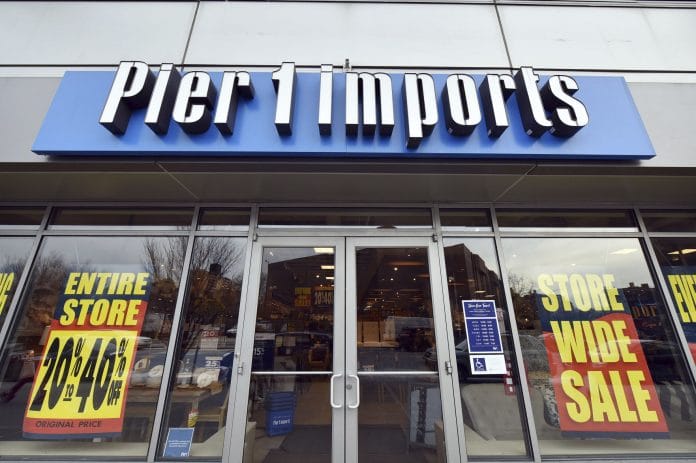What happened to Pier 1 Imports? Once a shining star among Fort Worth-based companies, the once-trendy supplier of home goods like papasan chairs and throw pillows filed for bankruptcy protection on Feb. 17 after years of sliding sales and corporate revival plans.
The company and its subsidiaries started voluntary Chapter 11 proceedings in the U.S. Bankruptcy Court for the Eastern District of Virginia.
The retailer, which was founded in 1962, has been struggling with increased competition from trendy (once something people said about Pier 1) online retailers such as Wayfair as well as retail giants like Walmart and Target. Pier 1 said it will pursue a sale, with a March 23 deadline to submit bids.
Get in line. It may not be very long.
“I knew it was coming,” said Marvin J. Girouard, who worked at the company for 32 years and was CEO from 1998 to 2007.
“When I left, we were doing $2.8 billion with about 1,500 stores and now after they closed these 450 stores, I think they’ll be down to 600 and something with doing, you know, $800 million or something like that,” he said.
That’s still enough for a chain if someone buys it, he said.
It’s not been easy to sit on the sidelines and watch.
“It’s like somebody who had cancer and kept, you know, not treating it or trying to treat it with the wrong remedy. And it kept getting worse and worse and worse. I’ve watched it since I left. It’s been 13 years this month,” he said.
Girouard is hardly alone.
Ted Gavin, a retail bankruptcy expert and managing partner of the consulting firm Gavin/Solmonese, said he hasn’t shopped at Pier 1 in more than a decade.
“People have been talking about Pier 1 heading for bankruptcy for a few years now. They’ve closed stores, they’ve struggled to find a steady customer base, they’ve struggled with falling sales,” Gavin said.
In the meantime, Pier 1 said lenders have committed approximately $256 million in debtor-in-possession financing so it can continue its operations during the Chapter 11 proceedings.
Pier 1’s sales fell 13% to $358 million in its most recent quarter, which ended Nov. 30. It reported a net loss of $59 million for the quarter as it struggled to draw customers to its stores.
Last month, in what sounded like the man yelling “Bring out yer dead,” in Monty Python and the Holy Grail, Pier 1 announced it would close 450 stores, including all of its stores in Canada. The company is also closing two distribution centers.
In a 2018 presentation to investors, the company acknowledged that shoppers thought its merchandise was outdated and expensive. It was also burdened by high sourcing and supply chain costs.
Not a recipe for success in the brutal, take-no-prisoners world of 2020 retail.
Pier 1 was founded in 1962 in California, where it made its name selling incense, beanbag chairs and love beads.
It was far out, man and consumers flocked to the funky, cool and hard-to-find products from all over the world. The company moved to Texas in 1966, got a little more mainstream, and went public in 1970.
And the company became part of the Fort Worth community with both it and RadioShack and Tandy Corp., bringing an international, exotic even, flavor to little ol’ hardscrabble Cowtown.
“I didn’t grow up here,” Girouard said. “But I thought it was just a great community to live and raise children in.”
Living here, made a difference, Girouard said, noting that his successor, Alex Smith, lived in Dallas.
“I always got involved with the United Way and you know, internationally with UNICEF and I [told Smith] I hope you’ll continue that.”
That didn’t happen and in recent years, Pier 1 struggled to draw customers to often cramped and cluttered stores.
Aside from damaging the relationship with the community, the company’s made critical errors in how it dealt with its vendors.
“These last people just killed all the relationships [Pier 1] had,” Girouard said. “They came out of that Kmart, low, low margin end mentality and they killed all the 35-year buildup of vendors we had and killed their commissions.”
The original vendors did more for the company than people understood because they also did quality control and shipment control and all that, he said.
The company has attempted all sorts of Acme-based coyote-type schemes to streamline its merchandise, improve online sales and draw in younger customers, but Pier 1 was way behind the roadrunner curve and attempts to update its image either blew up or fell flat on the pavement.
On the day it filed bankruptcy, Pier 1 was selling a tufted velvet armchair for a sale price of $399 on its web site. Target was offering a similar one for $214.
In its most recent fiscal year, which ended in February 2019, Pier 1 reported sales of $1.55 billion. That was down 18% from 2015. Pier 1’s sales tumbled 13% to $358 million in its most recent quarter, which ended Nov. 30.
As usual, in the conference call for the latest earnings, management bemoaned the fact that it has not made inroads online and that other competitors are eating into their market.
Girouard doesn’t buy it.
“Everybody is quick to say, ‘Oh, the internet killed them.’ And that’s not true. The internet didn’t kill them at all,” he said.
“They just killed themselves with poor hires and poor management.”
The Associated Press contributed to this report.






